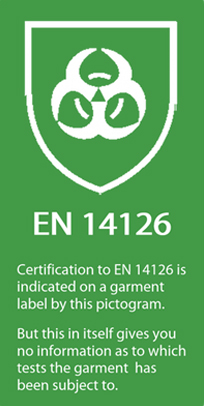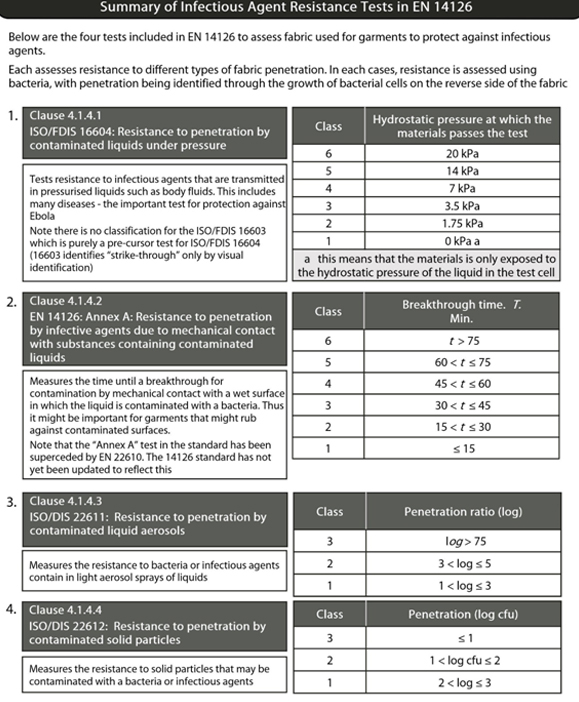Coronavirus 2019-nCoV Update: Virus Size and Understanding EN 14126
Our blog last week looked at the general recommendations for protective clothing for use in applications involving the Coronavirus 2019-nCoV. This follow up blog considers the importance of correctly interpreting the EN 14126 standard and especially the importance of the ISO 16604 test within it – for this and any other infectious agent protection.
The spread of Coronavirus 2019-nCoV continues. Quoting related statistics today seems pointless; tomorrow they will be considerably out of date. Suffice to say it is highly likely to continue to spread, so ensuring appropriate protection is more important than ever.

When we talk about appropriate protection against infectious agents, we have to talk about EN 14126.
EN 14126 is the standard for clothing for protection against infectious agents. It consists of four tests to assess a fabric’s ability to resist penetration of a bacterial or viral infection in a medium, such as a body fluid or on a contaminated surface. For those involved in selecting workwear for such protection, understanding this standard is vital, especially as there is considerable confusion around it. There are four important aspects on which to be clear;
- What does it test?
- What does Certification to it tell you and how should it be used?
- What are the key tests within it?
- Clearing up the confusion between the ISO 16603 and ISO 16604 tests
Each of these is discussed below.
- 1. What does the EN 14126 standard test?
The standard contains tests against fabrics only and no testing or certification of finished garments. Garment design for infectious agent protection is addressed in the standards that define EN “Types”:
- EN 13034 (for Type 6 protection against Aerosol Sprays),
- EN 13982 (for Type 5 protection against hazardous dry particles), and
- EN 14605 (for Type 3 and 4 protection against jet and shower-type sprays of liquids). It is these standards that define the garment design requirements).
- EN 943 (For Type 1 protection against gases and vapours)
- Thus garments certified to the Type standards AND EN 14126 will be labelled as meeting “Type 6” or Type 3” and so on, and have the suffix “–b” added. When you see a garment labelled with “Type 6-b” it means the garment construction meets the requirements of Type 6 and the “-b” means it is also certified to EN 14126.

- 2. What does certification to this standard tell you and how should it be used?
Certification to EN 14126 – that is, the presence on the garment label of the pictogram and the “-b” suffix – alone tells you nothing about the type of infectious agent it is suitable to protect against. Different viral and bacterial infections behave and transmit differently and will use different routes of contamination. As such, the standard contains four tests, each of which measures resistance against different types of contamination (the details of the different tests along with the classifications are shown in the table at the bottom of this blog).
With this considered, a garment may be certified to EN 14126 but may have been tested to ONLY ONE of the four tests and achieved the lowest classification; or it may have been tested to ALL FOUR of the tests and achieved the highest classification in each. The basic information advising certification on the label will be the same.
- Furthermore, if –for example – a garment has been tested only to ISO 22612, the test against penetration of contaminated dry particles, this would have little relevance to protection against Coronavirus 2019-nCoV. This is because it is primarily transmitted in moisture droplets resulting from coughs and sneezes (though like other cold and flu viruses it can probably also survive on contaminated surfaces) which is dealt with by ISO 22610 (this has now replaced EN 14126:Annex A).
- So certification to EN 14126 alone DOES NOT indicate that a garment is suitable for protection against this or any other infectious agent.
- To judge whether a garment is suitable for the protection you need, you must:
- 1) understand the routes of contamination in a particular environment (or relating to a particular infection) and
- 2) look at the garment’s User Instructions (or data sheet) to discover which tests it has been subjected to and whether they are relevant.
- 3. What are the key tests within the standard?
- Of the four tests, ISO 16604 is particularly relevant in this (and any viral protection) case.
- Furthermore, if –for example – a garment has been tested only to ISO 22612, the test against penetration of contaminated dry particles, this would have little relevance to protection against Coronavirus 2019-nCoV. This is because it is primarily transmitted in moisture droplets resulting from coughs and sneezes (though like other cold and flu viruses it can probably also survive on contaminated surfaces) which is dealt with by ISO 22610 (this has now replaced EN 14126:Annex A).
- So certification to EN 14126 alone DOES NOT indicate that a garment is suitable for protection against this or any other infectious agent.
- To judge whether a garment is suitable for the protection you need, you must:
- 1) understand the routes of contamination in a particular environment (or relating to a particular infection) and
- 2) look at the garment’s User Instructions (or data sheet) to discover which tests it has been subjected to and whether they are relevant.
- 3. What are the key tests within the standard?
- Of the four tests, ISO 16604 is particularly relevant in this (and any viral protection) case.
- But why?
- Well, each of the four tests uses a medium contaminated with a bacteria type. The table below shows the type in each test, the size of the contaminant used and the known size of Coronavirus 2019-nCoV.
* Note: This information is taken directly from the EN standard
It can be clearly seen that only the ISO 16604 test uses a contaminant – a bacteriophage (that is, a virus that parasitises a bacteria by infecting it, in this case Phi X174, selected, according to the standard, for its small size) – that is considerably smaller than the Coronavirus now filling the news. The other tests use bacteria considerably larger than Coronavirus. Thus, ISO 16604 is the only test providing a clear indication of effective resistance to penetration of that size of infectious agent.
In summary, therefore, specifiers of protective clothing should look for garments that are not only certified to EN 14126, but have also achieved a good classification in the ISO 16604 test.
4. ISO 16604 vs ISO 16603: Clearing up the Confusion
The EN 14126 standard contains only FOUR tests – not five as some manufacturers suggest. A common claim by some producers and suppliers is that their garment is suitable because it achieves a classification in ISO 16603. This is incorrect; there is no classification in the standard for ISO 16603 test results and ISO 16603 is an inferior test to 16604: it is not intended to indicate any level of protection.
The standard is quite clear about this. Whilst the ISO 16603 test is referenced, it is categorically stated that it is a “pre-cursor” test to be conducted in preparation for ISO 16604.
The key test (ISO 16604) measures the pressure at which “breakthrough” of the medium containing the bacteriophage will occur. To confirm penetration, a culture is grown from any penetrated medium in order to confirm viral penetration.
ISO 16603 exists purely to reduce the work and cost of ISO 16604. To avoid having to test at every pressure until “strike through” is identified, ISO 16603 uses synthetic blood in a simple visual penetration test to estimate the pressure at which strike through is likely to occur in ISO 16604. Testing to ISO 16604 can then proceed at this pressure as a starting point.
However, the 16603 test does not use any contaminants (as do the other tests) and the classification table applies ONLY to the results of ISO 16604. This is clearly confirmed in Clause 4.1.4.1 of the standard.
(In fact – and commonly – products claiming an ISO 16603 classification do so because they fail the ISO 16604 test, so for any garment claiming a classification to 16603, it is worth checking the test result for 16604)
In conclusion, those specifying clothing for protection against Coronavirus 2019-nCoV should primarily look for a garment that achieves a high classification in the ISO 16604 test as well as being certified to EN 14126. Do not make the error of assuming that a classification to ISO 16603 is either equivalent or correct as some manufacturers suggest or imply.
In terms of design, garments should also be at least certified to EN 14605 Type 4 which requires sealed seams and a sealable zip cover to minimise the possibility of ingress via those routes… in other words, a garment labelled as Type 4-b.
For more information on garment selection for Coronovirus2019-nCoV you can read our detailed blog here or download our fact sheet here.



Leave a Reply